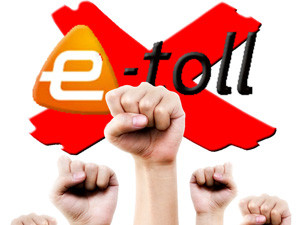
It has been over 20 months since the Opposition to Urban Tolling Alliance (Outa) launched court action against government's e-toll project, two months since the alliance's legal fight came to an end, and two weeks since the controversial system went live - but the battle rages on.
While the SA National Roads Agency (Sanral) says the e-toll system - which the state-owned entity has been tasked with administering - is of a world-class standard, and has seen increasing numbers of motorists buying in, Outa vehemently begs to differ.
This morning, Outa chair Wayne Duvenage released updated figures on the number of tagged vehicles on Gauteng's roads, based on a sample of just over 5 000 freeway users. According to this, he says, Outa notes the e-tag uptake has been "far lower" than initially anticipated.
"We always knew that Sanral's e-tag sales were inflated over the past two years, but we never expected the actual e-tag numbers in use to be this low," says Duvenage.
Last week, Sanral spokesperson Vusi Mona said 890 388 vehicle licence number/e-tags had "been committed". At the time, Outa disputed this, based on a physical count done on a sample of 2 098 cars using the freeways - of which, the alliance found 317 were tagged (15%).
Through a process of extrapolation, taking into account the total number of unique vehicles using the Gauteng freeways per month (about 2.3 million, according to Sanral), Outa calculated the maximum number of e-tags in use to be around 350 000.
E-tag elusion
He says Outa has re-examined the penetration of e-tag sales by expanding its freeway sample size from just over 2 000 to 5 000. Based on the findings, says Duvenage, Sanral will have a problem meeting its budgeted revenue. "E-tolls [is] headed for failure," says Outa in its latest statement.
"Until e-tolling started, the public had no way of knowing what the e-tag penetration rate was, and were always reliant on Sanral's figures to get a sense of the buy-in. However, Sanral has never been willing to openly show their source of information from their computer screens to independent journalists and other interested parties."
Outa started probing Sanral's claimed e-tag figures in July this year, saying something was amiss. At that time, the agency was stepping up its e-toll marketing campaign, claiming e-tag sales that didn't add up and which were disputed by Outa.
As a result of the confusion sown, says Duvenage, Outa believed the credibility of Sanral's information was "dismal".
Following the 20 November announcement by transport minister Dipuo Peters that e-tolling would go live at the beginning of this month, Sanral said it expected e-tag sales to pick up dramatically.
While the figure had been hovering around 600 000 for some time before a solid go-live date looked imminent, Sanral CEO Nazir Alli last month said he had faith that the people of SA would comply. He said, in the month since e-toll tariffs were gazetted, 100 000 e-tags were suddenly purchased. "I am confident people will embrace the system now. I think many were just waiting for this day and this announcement."
Regarding Sanral's latest 900 000 figure, Outa says: "If it is to be believed, something is seriously amiss and we can only ascribe their number to include e-tags farmed off to car rental and other fleets in other parts of the country, plus the hundreds of thousands of e-tags lying around in shops and storerooms, which are in effect useless unless they are fitted in cars and creating easy revenue generation for Sanral."
However, Mona says the e-tag figures Sanral has released are accurate, and accuses Duvenage of continuing to "play in the mud" despite having lost in court and not having intimate knowledge of the goings-on at Sanral.
"As a state-owned entity, everything we do is subject to audit processes by both the Auditor General and our external auditors. We have no reason to 'fabricate' these figures, as Outa alleges."
Business compliance
Further to its overall e-tag count, Outa says it was able to glean from research that intersections located closer to industrial areas (Modderfontein, Marlboro Drive, Malibongwe and New Road) produced a slightly higher e-tag count (average of 18%), compared to those around residential areas (at an average of 13%).
"This somewhat confirms the notion that business is slightly more likely to 'tag along', while the public are not, but even so, the business count at just below 20% was still a massive blow to Sanral's plans."
The alliance says this is a "greater indication" of societal defiance against e-tolling than imagined. "In addition, one can deduce that a low e-tag uptake will probably mean not much payment will be received from the non-tagged element of the freeway users. Outa estimates that even if Sanral manages to extort some payment from part of the non-tagged users at higher tariffs, they will be lucky to receive 40% of their targeted e-toll revenue, and as a result, the system will be doomed."
Sanral maintains it is confident it will meet its debt obligations and that the improved rating by Moody's a few days after toll commencement - though still negative - is an indication of a "modest step in the right direction".
Share